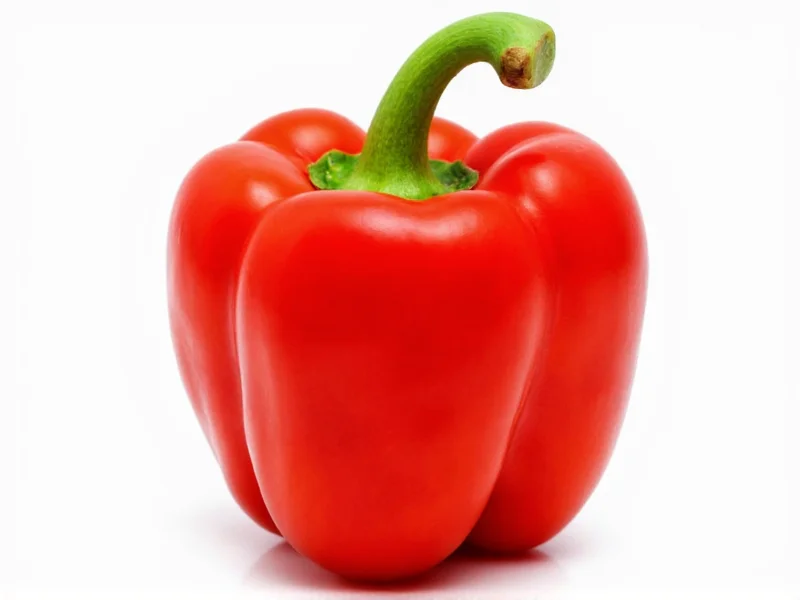Understanding the exact calorie content of bell peppers is essential for anyone tracking their nutritional intake. Whether you're meal prepping, following a specific diet, or simply making healthier food choices, knowing how many calories is in a bell pepper helps you make informed decisions about your meals.
Nutritional Profile of Bell Peppers by Color
Bell peppers come in various colors, each with slightly different nutritional profiles. While the calorie difference between colors is minimal, the vitamin content varies significantly. All bell peppers are predominantly water (about 92%), making them naturally low in calories while providing hydration and essential nutrients.
| Bell Pepper Color | Calories (per 100g) | Calories (medium pepper) | Key Nutrients |
|---|---|---|---|
| Green | 20 | 24 | Vitamin C, Vitamin K, Folate |
| Red | 31 | 37 | Vitamin A, Vitamin C (nearly 3x green), Antioxidants |
| Yellow/Orange | 30 | 36 | Vitamin C, Beta-carotene, Potassium |
Why Bell Peppers Are a Nutritional Powerhouse
When considering how many calories in a medium bell pepper, it's equally important to examine what those calories deliver nutritionally. Bell peppers provide impressive nutritional value relative to their calorie count:
- Vitamin C content: One medium red bell pepper contains approximately 152mg of vitamin C, which exceeds the daily recommended intake for adults. This powerful antioxidant supports immune function and skin health.
- Vitamin A benefits: Red bell peppers are particularly rich in beta-carotene, which converts to vitamin A in the body, supporting eye health and immune function.
- Fiber contribution: A medium bell pepper provides about 2.5g of dietary fiber, aiding digestion and promoting satiety despite the low calorie count.
- Antioxidant variety: Different colored peppers contain unique phytonutrients that combat oxidative stress in the body.
Comparing Bell Pepper Calories to Other Common Vegetables
Understanding where bell peppers fall on the calorie spectrum compared to other vegetables helps contextualize their place in a balanced diet. When examining bell pepper nutrition facts alongside similar produce:
- Bell peppers have fewer calories than corn (134 calories per cup) and peas (118 calories per cup)
- They contain slightly more calories than cucumbers (16 calories per cup) but offer significantly more vitamins
- Bell peppers have comparable calories to zucchini (20 calories per 100g) but provide more vitamin C
- They're lower in calories than potatoes (77 calories per 100g) while offering different nutritional benefits
Practical Applications for Calorie-Conscious Eating
Knowing are bell peppers low calorie is valuable information for various dietary approaches. These versatile vegetables work well in numerous eating plans:
For weight management, bell peppers provide volume and crunch with minimal calories, making them excellent for adding substance to salads, stir-fries, and snacks without significantly impacting daily calorie goals. Their natural sweetness satisfies cravings for sugary foods while delivering essential nutrients.
Cooking methods affect the final calorie count. Raw bell peppers maintain their natural low-calorie profile, while roasting or sautéing with oils will increase the total calories based on the amount of fat added. For those tracking bell pepper calories vs other vegetables, consider preparation methods when calculating total meal calories.
Maximizing Nutritional Benefits
To get the most from your bell peppers while maintaining awareness of their calorie content:
- Eat them raw when possible to preserve heat-sensitive vitamins like vitamin C
- Pair red bell peppers with healthy fats (like olive oil or avocado) to enhance absorption of fat-soluble vitamins
- Store properly in the refrigerator's crisper drawer to maintain freshness and nutritional value
- Use different colors throughout the week to benefit from the varied phytonutrient profiles
Common Questions About Bell Pepper Nutrition
Many people researching calories in a red bell pepper have related questions about incorporating these vegetables into their diets. Understanding the complete nutritional picture helps make informed dietary choices that align with personal health goals.











 浙公网安备
33010002000092号
浙公网安备
33010002000092号 浙B2-20120091-4
浙B2-20120091-4